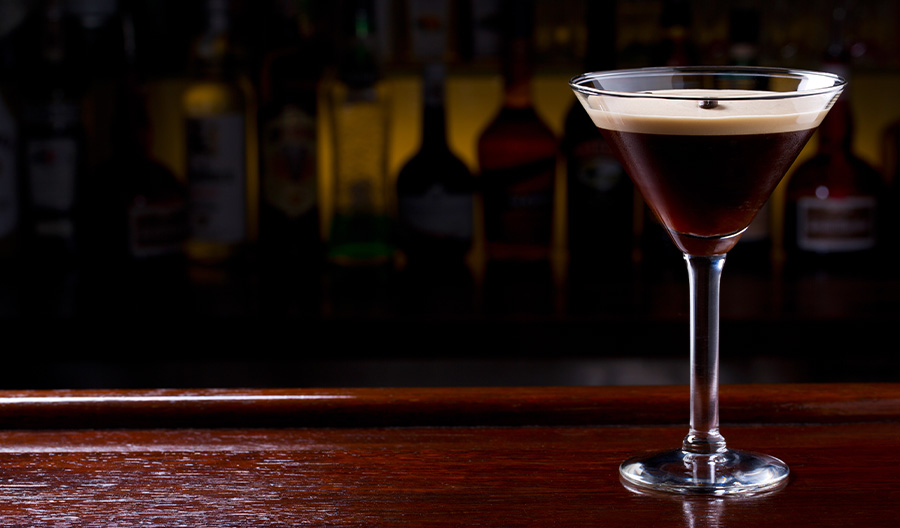The Espresso Martini is a cocktail that can easily ruin a bartender's night, especially if your bar isn’t prepared to serve them. Over the last couple of decades, American bartenders might have been able to get away with some questionable shaken mixture that may or may not have included actual espresso. But after the New York Times put the caffeinated cocktail back on its dusty pedestal with its story titled “The Espresso Martini Is Everywhere (Again),” everyone from the passionate drinks enthusiast to the casual imbiber seems to be experiencing a reignited interest in the (in)famous caffeinated cocktail.
Unlike in Europe, where coffee culture is prevalent throughout most major cities, most American cocktail bars don’t have espresso machines on their back bars to make this drink on the fly. But pulling a fresh shot of espresso and then shaking it over ice with vodka, coffee liqueur, and simple syrup doesn’t yield optimal results, either, because the hot liquid melts the ice, yielding a cocktail that’s overdiluted.
Today, most cocktail bars that receive a substantial number of Espresso Martini orders either have prebatched the entire cocktail, ready to be shaken over ice and poured, or have cold-brew/chilled espresso stocked to accommodate orders built from scratch. But at high-volume bars that sell hundreds of cocktails a night, tossing an Espresso Martini on nitro draft can save bartenders the late-night wear and tear and speed up service, making your bar more profitable in the process. This is how to do exactly that.

Ingredients and Batch
As with any cocktail that’s put on draft, whether carbonated or nitrogenated, it’s important to add the proper quantity of water for dilution to compensate for the fact that you won’t be shaking it with ice. This percentage starts at 8% and is often higher, depending on what works best with your recipe specs and draft system; you’ll likely want to experiment on a small scale before creating a large batch for a keg. To do this, create small batches with varying percentages of water and put them on a small nitro-brew keg, or dispense individual servings via an iSi whipper with an N2O charger. (Note that this will impart a slightly different flavor, since nitrous oxide adds a slight sweetness to the mix, but you can get the gist of dilution with the appropriate texture.)
After you figure out the amount of water needed for correct dilution, it’s then time to find the best coffee or cold brew to use. “Many recipes usually employ multiple expressions of coffee to achieve optimal flavor, texture, and foam stability,” says Guy Mazuch, the head of research, development, and centralized production at JKS Restaurants in the U.K. “You will usually find a cold-brew coffee or concentrate, as cold-brew coffees are great for the shelf life of the batch and add a good coffee flavor; but freshly brewed espresso is often used to add a richer coffee flavor that people associate with Espresso Martinis. The fresh espresso helps with the stability of the foam: Think about the crema that you get on a well-made espresso.”
After the coffee is sorted, the sweetener, vodka, and coffee liqueur are all a matter of preference. Mazuch’s recommended batch recipe, to use as a jumping-off point, is as follows; it yields one liter.
- 7.5 oz vodka
- 15 oz cold brew
- 9 Tbsp simple syrup
- 6 Tbsp freshly brewed espresso
- 4 tsp coffee liqueur
- 1/3 cup water
Equipment
Depending on your bar’s layout and design, the equipment you will need to put an Espresso Martini on tap will vary. Since there are a few ways to put the cocktail on a nitro draft, there is no one-size-fits-all solution, so it’s important to consider what will work best for your bar. That said, there are a few standard items that will be required in any case and a few technical details to clarify.
A nitro draft is a draft cocktail that is force-nitrogenated (that’s nitrogen, not to be confused with nitrous oxide, N2O). Nitrogen is odorless and tasteless and is basically insoluble in liquid, which is how the cascading effect of serving something ‘on nitro’ is achieved. Nitrous oxide, or laughing gas, is more soluble into liquid and has a sweet flavor. It’s a distinction that even some experts confuse, but an important one nonetheless.
For the actual kit, the following equipment and general setup are recommended:
- a direct-draw draft system from a walk-in cooler to the back bar
- a nitrogen generator, which pulls nitrogen from the air and holds it in a tank
- a high-pressure nitrogen regulator
- 5-gallon Cornelius keg outfitted with a diffuser stone on the gas inlet
- a stout faucet with creaming mechanism
If your space isn’t able to accommodate the system, a lo-fi alternative is to use a nitro cold-brew keg. Fill a stainless-steel basin with pebble ice to chill it and fit it in snugly. Ir is recommended to have two 64-ounce kegs that can be rotated.
With this lo-fi alternative, it is best to have several quarts of backup batches of the cocktail ready to go at all times, but that if your bar does an extremely large volume of Espresso Martinis, then this setup might not be the best option. It all depends on what makes the most sense for your bar.
Temperature and Technical Details
The method of putting a keg on pebble ice is a good indication of just how cold the keg should be in order to yield a satisfactory Espresso Martini. As is the case with any cocktail, on-draft or not, the temperature at which it’s served can influence the perception of its flavor, making this detail a vital one to ensure you’re serving an optimal drink. That said, temperature is one of the more difficult variables to control, as the length of your draft lines, the ABV of the cocktail, and other factors are all important considerations and vary from bar to bar.
Most people are limited to serving at refrigerator temp (about 34°F), because that’s what their draft system refrigeration is capable of achieving. While that is a great temperature to serve beer at, it is too warm for most cocktails. If you are limited to a standard refrigerator temperature range, aim for a low-ABV Espresso Martini of about 8 to 10%, since drinks with a lower alcohol content remain at cold temperatures for a longer time.
As for the technical setup, bars should make sure their draft lines are as short as possible. Every centimeter of line increases all of the variables.rom losing the temperature of the liquid, foam, to the nitrogen that has been dissolved into the liquid. Making your lines shorter will save hours of headache and ensure a decent serving temperature, as well as reduce wastage when cleaning the line.
Note that for bars that run their lines from a distant basement, this could be even more challenging. Balancing your keg will take a bit of calculation, so it’s probably best to consult with a professional if this isn’t your strong suit, or dig in and do a bit of technical research on keg setup.
As for actually serving the Espresso Martini once the system is set up, start by filling the keg two-thirds full to allow the nitrogen to dissolve into the cocktail (nitrogen is half as soluble in liquid compared with CO2). Then, chill the keg down to the desired temperature and set the nitro regulator to your preferred psi (pounds per square inch), and if the rest of your setup is good to go, tapping the cocktail is as simple as connecting the ball-lock disconnect to the keg and pouring.
Nitro Espresso Martinis are notoriously difficult to get right. Even bars that have achieved a decent serve still sees it as an ongoing project. In their eyes, they will never achieve perfection, and it has been the same story for us. The guest may think the serve is great, but we always want a better, thicker (or thinner for that matter), more stable foam.
The drink may be infinitely perfectible, but the pour you get when it’s put on nitro draft is still hugely better—and much easier on your bar team—than shaking up hundreds of individual orders each night.

